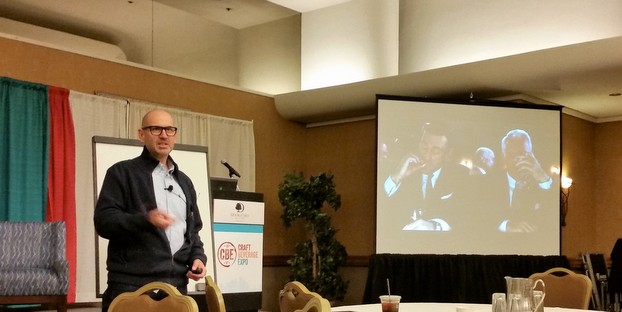Christian McMahan used to have a monthly marketing budget of a quarter million dollars; now, as a craft brewer, it’s a few hundred dollars. But he thinks you can still use that money to revive a brand and get consumers to take another look.
When he was with HEINEKEN USA, McMahan led the team that created the Dos Equis “Most Interesting Man in the World” campaign and was later VP of marketing for Guinness USA. Now he is president of Wachusett Brewing Company in Westminster, Mass., and he believes the same strategies he used with the big corporations can still be applied at a small craft brewery.
In his comments to a general session at Craft Beverage Expo 2017, McMahan emphasized targeting an audience, getting to know them, and then using all your marketing channels as smartly as possible.
Always be talking recruitment and retention
McMahan stressed that you should always talk explicitly about both recruiting and retaining strategies rather than just marketing strategies generally. He described the “Consumer 4A Model” as a way of breaking down these audiences:
Available consumers will drink beer, while Acceptors drink craft and the kinds of styles you brew. These are your recruitment pools. Adopters already have your brand in their “portfolio,” the brands they drink semi-regularly and could probably list off the tops of their heads as favorite breweries. Adorers drink your brand religiously and may have strong feelings about some of your competitors. These are your retention pools.
In any given campaign, you need to choose your audience and target them accordingly.
The Dos Equis Campaign
McMahan acknowledged indulged his audience’s curiosity about the “Most Interesting Man in the World” campaign by offering it as a case study of target marketing to create “brand reappraisal.”
It was actually designed as a recruitment campaign. Dos Equis had a small part of the Mexican lager market and McMahan’s team had a mandate to grab some more. They began by acknowledging that the product itself did not stand out among other Mexican lagers (a decidedly un-crafty position, but keep reading). So they set out to create a mythology that would speak to a new consumer audience.
They called their target audience “monsters”: males, 23-29, who drank 12 or more beers per week. They figured if they could get this large demographic to drink Dos Equis at least one of those 12 times, they’d see a good bump.
Of course, they had a huge budget and team, so they could spend 18 months developing the campaign, including three months of field research with actual “monsters.” The takeaway for a craft brewer, though, is that they learned unexpected things from this audience when they both listened and reflected on what they heard.
They drew two key conclusions about this audience and built the campaign around them. First, these males had a deep-seated fear of being perceived as boring—by their peers and by women. Second, they lacked older male mentors.
The “Most Interesting Man in the World” campaign offered them an interesting, older male mentor who could give them something both to laugh at and to aspire to.
McMahan pointed out that it was crucial that the humor was not broad but witty.
“Wit is laughter with intelligence,” he said, which is the approach to humor you need if you want to create a premium image.
Weigh evolution vs. revolution when rebranding
In his work at Wachusett, McMahan has targeted blue-collar New Englanders with a pride in their region and local sports. He wanted to update their packaging, but he determined that, for purposes of that market, they could evolve the visual brand rather than overhauling it completely.
So, they updated the labels and packaging to feature much of the same art or concepts but in more modern ways. Evolution helps consumers trust in the continuity of the product and brand while also drawing new attention to it.
Revolutionary rebranding, of course, carries the risk that you will lose old customers. People will think you’ve changed the company or the recipe, so you need to consider what your goals for rebranding are and then how you will go about it.
McMahan offered some straight talk about packaging and your visual brand, saying that you may need to hire someone other than your cousin who likes to paint or your friend who took a design course.
“Budgets are tight,” he acknowledged, “but you get what you pay for—and you should spend money on packaging.”
Don’t neglect other essential channels
As important as packaging is, McMahan stressed the importance of digital marketing. His take on the new marketing mindset is “So-Lo-Mo-Co,” or social, local, mobile and content.
Your digital marketing strategy should have these emphases in order to develop both share of mind and share of heart. So-lo-mo-co facilitates “share of heart” because when people can access great content (often on mobile devices) about local businesses, they will share it with their friends, many of whom are also local.
When creating social content, McMahan cautioned, you want to start conversations but not control them. Because consumers trust what they hear from peers more than what they hear from businesses, it is best to enable the conversation and then get out of the way and let consumers adopt them as their own.
He compared winning at social media to being inducted into the Baseball Hall of Fame. If you can play the game a long time and bat 0.333 (which is only 1 in 3), you can get in. Similarly, social isn’t about every post being a runaway winner but about getting back up to bat, trying again and again, and finding the winners along the way.
But it all came back to defining your audience as thoroughly as possible and speaking directly to them.
He even repeated the familiar marketing advice: “If you try to appeal to everybody then you appeal to nobody.”
This is a hard lesson for a small business to learn because you can be so focused on growing your customer base. But if the Dos Equis guy is succeeding with this at a craft brewery like Wachusett, it is probably a lesson worth learning.
Brad Fruhauff is a good dude, a great beer writer and a contributor to Craft Brewing Business. Plus, he wants to write for your brewery. Check out his other work here.






Leave a Reply
You must be logged in to post a comment.